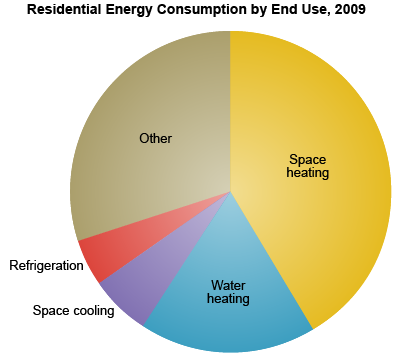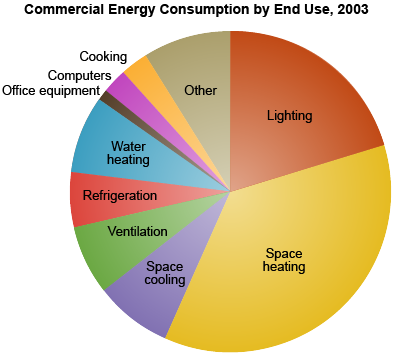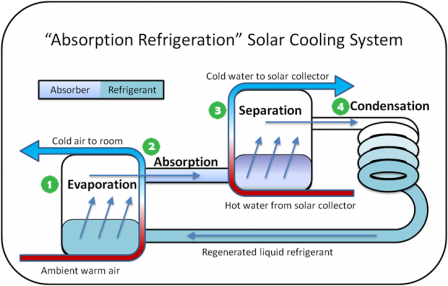Renewable Space Cooling
About Space Cooling
Space cooling represents a significant use of energy in buildings nationwide. Recent data suggest that space cooling accounts for about 6 percent of energy use in U.S. residences and about 8 percent of energy use in U.S. commercial buildings.1,2
Homeowners spend an estimated $35 billion or 14 percent of their total energy-related expenditures on space cooling alone, whereas commercial buildings spend more than $25 billion or 14 percent annually.3 The dominant fuel used for space cooling tends to be electricity. In 2010, space cooling in the residential sector produced an estimated 210 million metric tons of carbon dioxide emissions, with commercial buildings adding an additional 151 million metric tons per year.4
Requirements for cooling systems depend on the size of the spaces that need to be cooled, but these systems can generally be scaled up as long as there is enough energy available to run them.


These percentages are based on “site” or “delivered” energy, which is the total Btu value of energy at the point when it enters the building.
Data sources:- U.S. Energy Information Administration. 2012. 2009 Residential Energy Consumption Survey. Table CE3.1. Household Site End-Use Consumption in the U.S., Totals and Averages, 2009.
- U.S. Energy Information Administration. 2008. 2003 Commercial Buildings Energy Consumption Survey. Table E1A. Major Fuel Consumption (Btu) by End Use for All Buildings.
How Renewable Space Cooling Works
The simplest form of renewable cooling relies on pumping water from a cold reservoir or chilling water by pumping it through underground pipes. Other renewable thermal technologies can cool spaces using a technology called absorption refrigeration—a type of air conditioning that uses a refrigerant chemical to produce cold air from hot water. In both cases, renewable sources might be able to cover the entire load, or they can provide partial coverage and save money and energy as a supplement to traditional electric or thermal energy sources.
Chilled Water Distribution
This technology uses a ground source heat pump running in reverse to take advantage of the relatively constant temperature of the ground a few feet below the surface. Relatively warm water or refrigerant fluid can circulate through underground pipes, losing heat as the pipes come into contact with relatively colder ground. The fluid returns at a cooler temperature and can be used to chill water, which in turn can circulate through the building to create a simple and effective cooling system.
Absorption Refrigeration Cooling
Making cold air out of hot water is actually an old technology, invented in the 1850s. This technology relies on the process of evaporation. Turning liquid water into water vapor requires energy to break the bonds that hold water molecules together in liquid form.
Refrigeration follows the same principle that allows the human body to be cooled by sweating. When you sweat, the water molecules in your sweat absorb heat from your body in order to break the bonds holding them as a liquid. The water evaporates, and heat is removed from your body as a result.
Today’s air conditioners replace water with a more efficient refrigerant fluid, then reuse this refrigerant rather than releasing it to the atmosphere. This technology, known as absorption refrigeration, features four major steps, as the following diagram shows:

- Evaporation: The refrigerant absorbs heat from the indoor air as it evaporates, leaving chilled air or water behind.
- Absorption: The vapor is absorbed into another liquid, called the absorber. This step improves the speed and efficiency of evaporation by preventing the refrigerant from condensing, which would release heat back into the system and counteract the cooling that just took place.
- Separation: The mixture of refrigerant and absorber is heated until the refrigerant evaporates out of the absorber fluid. This is the most energy-intensive step of the whole process, and it is how air conditioners can use hot water to make cold air. The hot water for Step 3 can be produced by renewable sources.
- Condensation: The refrigerant is pumped through a condenser, which returns it to liquid form. Heat is released during the condensation process, and this heat must be vented to the outdoors. The liquid refrigerant returns to Step 1.
Compatible Renewable Technologies
Ground source heat pumps can run in reverse to provide chilled water for small-scale space cooling applications. In a renewable absorption refrigeration system, the thermal energy (heat) used to drive the cooling process is most commonly produced from concentrating solar collectors, but it can also come from any other thermal energy source, such as a direct geothermal well or a woody biomass furnace. Refrigeration cooling requires a higher level of heat than what is required for space heating or pool heating, so unglazed solar collectors are not adequate to drive these processes alone. Evacuated tube collectors can often produce water that is hot enough to support a refrigeration cooling system, as long as there are enough collectors for the size of the cooling system.
The interactive diagram below shows which renewable technologies can serve domestic or commercial space cooling applications. You can click any of the technologies to go to a new page with more detailed information.
Renewable Space Cooling Technologies and Applications
- View a text version of this diagram ►
- View an expanded version of this diagram to compare space cooling with other renewable heating and cooling applications ►
Understanding the Diagram
The diagram above shows technologies and space cooling applications in terms of the approximate “working temperature” range, which is the required temperature of the heat transfer fluid within the renewable cooling system. The working temperature is not necessarily the same as the final temperature of the end product (in this case, the heated air or water that is ultimately being delivered).
The diagram above shows approximate working temperature ranges. The exact working temperature requirements for a particular building or cooling system will depend on factors such as system type, size, and location. The working temperature that a particular renewable technology can supply will also depend on site-specific factors. For example, the amount of heat that a solar collector system can supply will depend on how much sunlight it receives, and at what angle.
Learn More About Renewable Space Cooling
Key Renewable Technologies
Key End Use Sectors
Technical Resources
1U.S. Energy Information Administration. 2012. 2009 Residential Energy Consumption Survey. Table CE3.1. Household Site End-Use Consumption in the U.S., Totals and Averages, 2009. These totals are based on “site” or “delivered” energy, which is the total Btu value of energy at the point when it enters the building.
2U.S. Energy Information Administration. 2008. 2003 Commercial Buildings Energy Consumption Survey. Table E1A. Major Fuel Consumption (Btu) by End Use for All Buildings. These totals are based on “site” or “delivered” energy, which is the total Btu value of energy at the point when it enters the building.
3U.S. Department of Energy. 2011. Buildings Energy Data Book. Accessed in October 2014. Expenditure data are from 2010.
4U.S. Department of Energy. 2011. Buildings Energy Data Book. Accessed in October 2014. Emissions data are from 2010.
